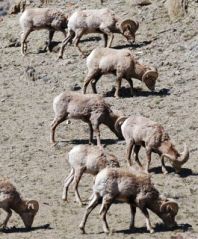 Bighorn Sheep Near Mt. EvertsLast spring, I climbed the shoulder of Mt. Everts and stopped to eat lunch. As I sat comfortably on a boulder munching a peanut butter and jelly sandwich, a large herd of bighorn sheep descended from a ridge behind me and to my surprise surrounded me. Curious, but not frightened, they began to forage near my resting place. I sat still, not wanting to frighten the animals (and not being able to walk through the herd) and waited until they passed. My astonishment prevented me from finishing my lunch—I remained almost motionless and utterly transfixed as I watched these magnificent animals for an hour before they moved to greener pastures.
Bighorn Sheep Near Mt. EvertsLast spring, I climbed the shoulder of Mt. Everts and stopped to eat lunch. As I sat comfortably on a boulder munching a peanut butter and jelly sandwich, a large herd of bighorn sheep descended from a ridge behind me and to my surprise surrounded me. Curious, but not frightened, they began to forage near my resting place. I sat still, not wanting to frighten the animals (and not being able to walk through the herd) and waited until they passed. My astonishment prevented me from finishing my lunch—I remained almost motionless and utterly transfixed as I watched these magnificent animals for an hour before they moved to greener pastures.
So began my absolute enchantment with bighorn sheep.
A bighorn sighting eluded me during my twenty years hiking in the Sierra Nevada; my closest encounter came when ranger Dick Ewart and I discovered bighorn tracks at the top of the Granite Divide in Yosemite. The naturalist Jack Laws and I also embarked on a failed mission in search of the sheep outside of Bishop that resulted in a drowned Subaru but no bighorn.
 Bighorn on Gardner RiverYellowstone, however, has no shortage of the animal. When I traveled to the park for my job interview last fall, I drove through Gardiner and suddenly slammed on my brakes in amazement as I saw six bighorn resting on the side of the road.
Bighorn on Gardner RiverYellowstone, however, has no shortage of the animal. When I traveled to the park for my job interview last fall, I drove through Gardiner and suddenly slammed on my brakes in amazement as I saw six bighorn resting on the side of the road.
Since moving to Yellowstone, I’ve been fortunate enough to observe the bighorn frequently as they spend most of the year roaming the hillsides and ridges adjacent to my home.
Last week I spent an hour gazing at the bighorn sheep as they danced on the cliffs in the Gardner River Canyon—a graceful ballet with nature as the stage. As Dale Toweill notes in his book Rocky Mountain Bighorn Sheep:
“Like a ballerina, bighorns walk on the tips of two toes. Their outer hooves are modified toenails, exquisitely shaped to grip any slight protrusion, while the base of the foot---the end of the toe—forms a soft pad that conforms to each surface preventing slippage. The cone-shaped foot is tightly wrapped with tendons, transferring the pressure from the hoof to the muscular legs—a marvel of engineering.”
Watch these impressive animals scale the cliffs in my video of the bighorn ballet:
 The bighorn sheep, rams especially, carry a heavy load while leaping from ridge to ridge. An adult ram’s horns can weigh up to forty pounds and account for 8-12 percent of its body weight. Horns also denote social status in males, with the general rule being the bigger the horn the higher the ranking.
The bighorn sheep, rams especially, carry a heavy load while leaping from ridge to ridge. An adult ram’s horns can weigh up to forty pounds and account for 8-12 percent of its body weight. Horns also denote social status in males, with the general rule being the bigger the horn the higher the ranking.
Although many consider the curled horn the most striking feature of a bighorn, I have to cast a vote for their golden-orange eyes. When a bighorn gazes at me with its peaceful, curious visage, those wide-set, ancient eyes calm my spirit. The gentle gaze is misleading, however, as bighorns consider staring bad manners or an indication of threatening behavior.
